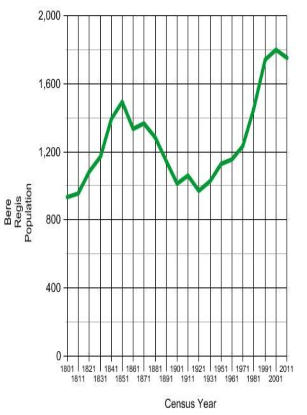Bere Regis has known more illustrious times-and even royal patronage-during its 1,000 years or more of history.
If the parish as a whole is considered, the history of human occupation and settlement goes back much further, and archaeological remains show the higher downland in the northern part of the parish to have been continuously occupied from Neolithic times (2500-1900 BC) until the Roman period (AD 43-AD 410).
The village itself was established in its present position as a small settlement during Saxon times, in common with most other English towns and villages, but by the 13th century it had grown to town status, having been made a free borough during the reign of King Edward 1 (1272-1307), although members do not appear to have been elected to parliament.
In 1215 a charter for a market was granted by King John, and this weekly market was still being held on Wednesdays in 1861, but it had by then become very small, subsequently ceasing altogether.
The growth from Saxon village to town status in the 13th century could have been due to two main factors; the importance of the annual fair on Woodbury Hill which originated early in the 12th century to become one of the largest in the south of England, and the 16 visits to the manor by King John during his reign (1199-1216).
After this time the fame and fortunes of Bere Regis were closely bound to those of the powerful and influential Turberville family who were lords of the manor from the 13th to the 18th centuries. In addition,
Cardinal Morton, who was born at Milborne Stileham which then formed part of this parish, and who was so influential in national affairs, was said to have been "much given to building", and the result of his continued association with his native parish is still apparent in the late 15th century work of the parish church for which he was largely responsible.
Little, if any, evidence of these former associations can now be seen in the village itself, but the magnificent parish church has survived from mediaeval times, and contains portions of work carried out at various periods under the influence of the Turbervilles and Cardinal Morton.
A close architectural study of the church shows it to have originated as a small cruciform building in the mid llth century, and to have grown to its present size by the end of the 15th century by a series of additions and enlargements, reflecting as it were the growth of the village itself.
In some parishes it is possible to give a population figure at the time of the Domesday Survey of 1086, but as the manor of Bere Regis was at that time royal domain it was not as a result included separately in the survey.
Approximate populations can be calculated from the various lists compiled in the 16th and I7th centuries such as the 1542 muster roll, the 1641 protestation returns and the 1662 hearth tax assessments, but the formulae far so doing are uncertaln and the results unreliable.
Reliable figures are however available from the ten-yearly census returns which commenced in 1801.
Until 1901 Milbourne Stileham was included with Bere Regis, but in the list which follows the population figures for that former part of the parish have been omitted:
1801 - 936 1911 - 1,059
1811 - 953 1921 - 970
1821 - 1,080 1931 - 1,027
1831 - 1,170 1941 - No Census
1841 - 1,394 1951 - 1,130
1851 - 1,494 1961 - 1,157
1861 - 1,336 1971 - 1,235
1871 - 1,366 1981 - 1,450
1881 - 1,284 1991 - 1,740
1891 - 1,144 2001 - 1,797
1901 - 1,014 2011 - 1,750
The Graph here clearly shows how the Population has changed over the years.
Please note that no Census was conducted in 1941, due to the Second World War.
The above figures show a marked increase during the first half of the 19th century from 936 in 1801 to the all time peak of 1494 in 1851, at which time the industrial revolution had begun to take effect, and the resultant decline of rural areas is reflected in the figures which then continue to decrease until the end of the century.
Another low point occurred in 1921 as a result of world war 1 and its accompanying post war depression, but an increasing trend which then began is still continuing at the present time.


